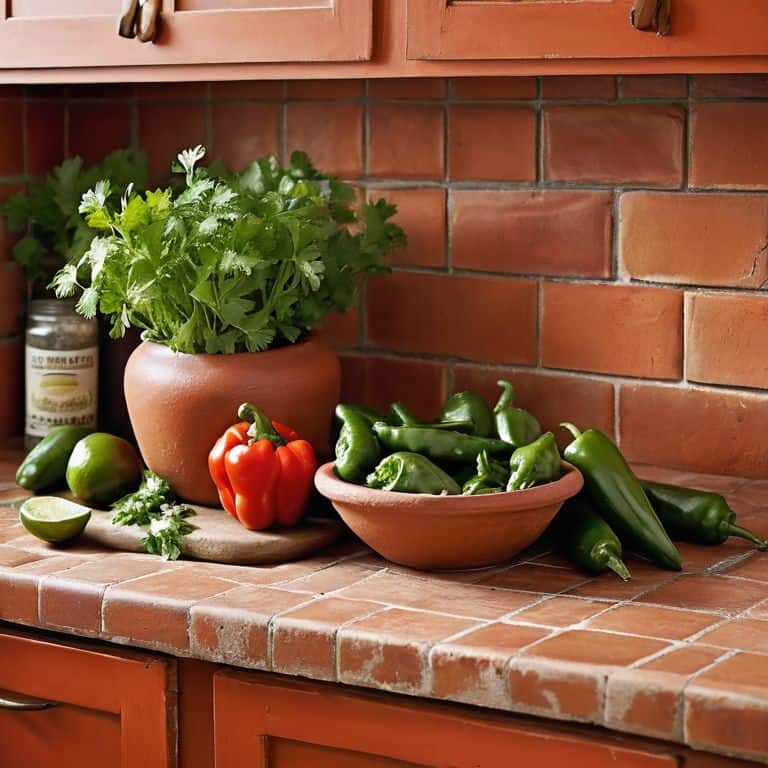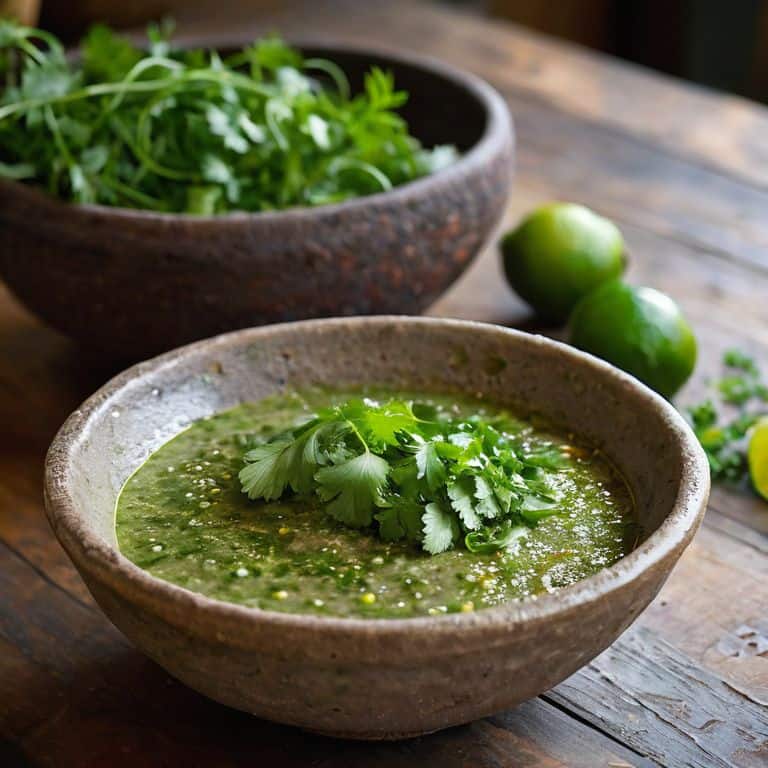I still remember the first time I tried to make authentic salsa verde in my own kitchen, only to be disappointed by the lackluster flavors. I had followed all the recipes I found online, but something was missing. It wasn’t until I met an abuela in Mexico City, who shared with me her secrets for capturing the raw, vibrant taste of the street food markets, that I understood the true power of using fresh, locally-sourced ingredients. The common myth that you can simply substitute ingredients with whatever is available at your local supermarket is a recipe for disaster. When it comes to how to make authentic salsa verde, the truth is that there’s no substitute for the real thing.
As I share my own journey to mastering this iconic sauce, I promise to cut through the hype and bring you honest, experience-based advice on how to make authentic salsa verde. I’ll take you with me to the bustling markets and hidden kitchens where I’ve learned the secrets of this beloved condiment. From the importance of using the right type of tomatillos to the simple, yet crucial techniques for balancing flavors, I’ll show you that making authentic salsa verde is within your reach. Whether you’re a seasoned cook or just starting out, I invite you to join me on this culinary adventure and discover the rich, vibrant flavors that await you.
Table of Contents
Recipe Details
Ingredients
- 1 cup fresh tomatillos husked and rinsed
- 1/2 cup fresh cilantro chopped
- 1/4 cup fresh onion chopped
- 2 cloves garlic minced
- 1 jalapeño pepper seeded and chopped
- 1 lime juiced
- 1 teaspoon salt
Tools & Supplies
- Blender or food processor
- Medium saucepan
- Strainer or fine-mesh sieve
Recipe Instructions
Step 1
First, start by gathering the freshest ingredients you can find, just like Abuela taught me – the quality of your ingredients is key to an unforgettable salsa verde. I’m talking about vibrant green tomatillos, fragrant cilantro, and juicy limes. Don’t even think about using the wilted stuff from the back of your fridge; we’re going for that raw, unbridled flavor that’ll transport your taste buds to the bustling streets of Mexico City.
Step 2
Next, roast your tomatillos over an open flame or in the oven until they’re slightly charred and blistered – this will bring out their natural sweetness and depth of flavor. I remember the smell of roasting tomatillos wafting through the markets in Oaxaca, enticing everyone to come and taste the magic of the street food vendors. Once they’re done, let them cool down before peeling off the skin and chopping them up into small pieces.
Step 3
Now it’s time to prepare the aromatics – onion and garlic are the backbone of any good salsa verde. Finely chop a small onion and a few cloves of garlic, then sauté them in a bit of oil until they’re softened and translucent. Don’t let them burn, as this will give your salsa a bitter taste; we’re aiming for a smooth, velvety texture that’ll coat your taste buds.
Step 4
In a blender or food processor, combine the roasted tomatillos, sautéed onion and garlic, a handful of chopped cilantro, and a squeeze of fresh lime juice. I like to add a dash of salt to bring out the flavors, just like Abuela used to do – the key is to taste as you go and adjust the seasoning to your liking. Blend everything together until you get a smooth, slightly chunky consistency that’s just begging to be scooped up with a crispy tortilla chip.
Step 5
Finally, taste and adjust your salsa verde to perfection. If it needs a bit more acidity, add a squeeze of lime juice; if it’s too thick, add a splash of water. I like to serve my salsa verde in small bowls, garnished with a sprinkle of fresh cilantro and a few crispy tortilla chips on the side – the presentation is just as important as the taste. Now, go ahead and dig in, and let the flavors of the street transport you to a world of culinary adventure and discovery.
Unlocking Salsa Verde Secrets

As I delved deeper into the world of salsa verde, I discovered that the key to its unmistakable flavor lies in the roasting process. The abuela who taught me this recipe would always say that roasting the tomatillos brings out their natural sweetness, which is then perfectly balanced by the tanginess of the fresh cilantro. I’ve found that using a roasted tomatillo recipe as the base for my salsa verde gives it a depth of flavor that’s hard to replicate with raw ingredients.
One of the things that sets authentic Mexican salsa ingredients apart is the use of serrano peppers, which add a unique brightness to the dish. However, I’ve learned that if serrano peppers are hard to come by, you can substitute them with a combination of jalapeño and Anaheim peppers to achieve a similar spicy kick. When it comes to enjoying your freshly made salsa verde, there’s no better accompaniment than a batch of homemade tortilla chips, crispy and warm from the oven.
For those who like a little extra heat, I’ve experimented with spicy salsa verde variations that incorporate diced habanero or ghost peppers. And for those who want to preserve their salsa verde for later, I’ve found that canning salsa verde at home is a great way to enjoy it year-round, without sacrificing any of the flavor or texture that makes it so special.
Abuelas Roasted Tomatillo Recipe
Abuela’s trick to intensifying the flavors of salsa verde was roasting her tomatillos to perfection. I recall her carefully placing them on a comal, watching as they charred and softened, releasing their deep, slightly smoky flavor. She’d then peel off the skin, revealing the tender flesh beneath, which would be blended into the salsa. This simple step added a richness that elevated the entire dish. I’ve carried this technique with me, and it never fails to transport me back to those vibrant Mexican markets. By roasting your tomatillos, you’ll unlock a depth of flavor that will make your salsa verde truly unforgettable.
Spicing Up With Serrano Pepper Substitute
As I wandered through the vibrant markets of Mexico, I discovered that the Serrano pepper’s subtle heat is a cornerstone of authentic salsa verde. But what if you can’t find these elusive peppers? I recall a wise grandmother in Oaxaca sharing her secret substitute: the Guajillo pepper. Its slightly sweet, smoky flavor adds a depth to the salsa that’s remarkably close to the real thing. When using Guajillo peppers, I like to rehydrate them in hot water before blending for an intense, velvety texture.
In a pinch, you can also experiment with a combination of Anaheim and Jalapeño peppers to approximate the Serrano’s unique bite. The key is to balance the flavors, so don’t be afraid to adjust the ratio to your taste. Remember, the beauty of salsa verde lies in its adaptability – it’s a recipe that thrives on experimentation and creative substitution.
Salsa Verde Like a Local: 5 Tips from My Mexican Kitchen Adventures

- Let the ingredients tell the story: I learned from Abuela that the best salsa verde is made with tomatillos that are slightly charred from the comal, giving them a smoky depth
- Respect the pepper: while serrano peppers bring the heat, they also add a bright, crisp flavor – don’t be afraid to experiment with substitutes, but remember, the essence of salsa verde lies in its balance
- Acidity is key: a squeeze of fresh lime juice can make all the difference in bringing the flavors of your salsa verde together, just like the street vendors in Mexico City who add a splash of citrus to their dishes
- Roast, don’t boil: Abuela’s secret to intensifying the flavor of her tomatillos is to roast them in the oven with some onions and garlic until they’re caramelized and tender, releasing their natural sweetness
- Texture matters: blend your salsa verde until it’s almost smooth, but still retains a bit of chunkiness – this is where the magic happens, and your taste buds will thank you for the extra effort, just like the satisfying crunch of a fresh tortilla chip
Bringing Salsa Verde to Life: 3 Essential Takeaways
To create an unforgettable salsa verde, it’s crucial to use the freshest ingredients, just as Abuela taught me in Mexico City – the raw, vibrant taste of the street food markets is unparalleled
Roasting tomatillos, as shown in Abuela’s recipe, brings out a depth of flavor that elevates salsa verde from a mere condiment to a culinary masterpiece
Don’t be afraid to experiment with substitutes, like using jalapeño peppers when Serrano peppers are scarce – it’s all about embracing the adventurous spirit of street food and making these flavors your own
The Heart of Authentic Salsa Verde
To make authentic salsa verde, you must first understand that it’s not just about following a recipe, but about capturing the essence of a culture – the laughter, the tears, and the generations of love that go into every roasted tomatillo and every sprinkle of cilantro.
Marco Bianchi
Savoring the Flavors of Authenticity

As I reflect on my journey to uncover the secrets of authentic salsa verde, I’m reminded of the vibrant street food markets where it all began. From Abuela’s roasted tomatillo recipe to the clever use of Serrano pepper substitutes, each element has been a testament to the richness of Mexican cuisine. By following these steps and embracing the beauty of traditional cooking methods, you’ll be well on your way to creating a truly unforgettable salsa verde that will transport your taste buds to the heart of Mexico City.
So, the next time you’re tempted to reach for a generic, store-bought salsa, remember that the true flavor of a culture lies in its authentic, homemade recipes. As you sit down to enjoy your freshly made salsa verde, surrounded by the people and memories you cherish, you’ll realize that the journey to create it was just as meaningful as the destination. And that, my friends, is the greatest ingredient of all – the love and connection that comes from sharing a delicious, homemade meal with others.
Frequently Asked Questions
What's the best way to select fresh tomatillos for Abuela's roasted tomatillo recipe?
When I was in Mexico City, Abuela taught me to choose tomatillos with a sweet, earthy aroma and a slight give to the touch. Avoid those with soft spots or dry, papery husks. The best ones will have a vibrant green color and a slight sheen to the skin – that’s when you know you’ve got the perfect ingredient for her legendary roasted tomatillo recipe!
Can I use other types of peppers as a substitute for Serrano peppers in salsa verde?
Ah, the pepper conundrum! I’ve found that while Serrano peppers add a unique zing, you can substitute with other hot peppers like jalapeños or habaneros in a pinch. Just be mindful of the heat level and adjust to taste. I recall a street food vendor in Oaxaca using guajillo peppers for a slightly sweeter, smokier flavor – it’s all about experimentation and finding your perfect balance!
How long can I store homemade salsa verde in the fridge to maintain its authentic flavor?
I’ve found that homemade salsa verde can be stored in the fridge for up to a week, but its vibrant flavor is best within three to four days. I recall a street vendor in Oaxaca telling me, “Freshness is key, amigo!” So, try to use it within a few days for that authentic, just-made taste.
